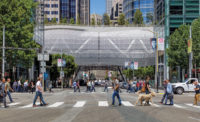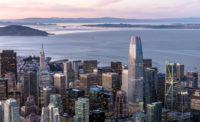It is often referred to as “the Grand Central of the West.” But while San Francisco’s Transbay Transit Center won’t look anything like New York’s Beaux-Arts commuter palace, it has been designed to be an impressive public amenity, not just a functional one. The 1 million-squarefoot Transbay facility, which replaces an outmoded and shabby 1930s station, won’t have a limestone facade or a ceiling depicting the stars. Instead, it will have a billowing, veil-like enclosure and expressive skylight-topped structural elements that the architects call “light columns,” which will allow daylight to penetrate the structure’s lowest levels. But the new station’s most unusual feature will be a publicly accessible garden over the entire almost-fiveblock- long building. “We were the only firm that proposed covering the station with a 5.4-acre park. This is the reason we were chosen,” says Fred Clarke, senior principal at Pelli Clarke Pelli, referring to his firm’s winning entry to a 2006 international competition.
The Transit Center’s first phase—with a total project cost of $2.3 billion, funded by a variety of local, regional, state, and federal sources—is slated to open late this year. It includes all of the station’s aboveground spaces: the rooftop park, a bus deck, a main hall, and a mezzanine level, as well as a below-grade “train box” for regional commuter rail and California’s planned high-speed line that should one day link San Francisco to Los Angeles. But the timing and financing of the second phase, including the rail connections, are still uncertain. For at least the next several years, only buses will be rolling in and out of the Transit Center.
The station is just one piece of a much larger redevelopment zone on the edge of San Francisco’s financial district, made possible in part by the demolition of an elevated freeway and its access ramps after the 1989 Loma Prieta earthquake. The approximately 145-acre area is envisioned as a high-density neighborhood of office buildings, hotels, and both market-rate and affordable housing. Pelli Clarke Pelli has designed what will be the tallest building in the district as well as the city—a 60-story tower for the enterprise software company Salesforce (above), slated for completion next year. Several other skyscrapers for the district are planned or are under construction, including buildings by Foster + Partners, Renzo Piano, and Jeanne Gang.
Back to Design for the Public Realm








Post a comment to this article
Report Abusive Comment